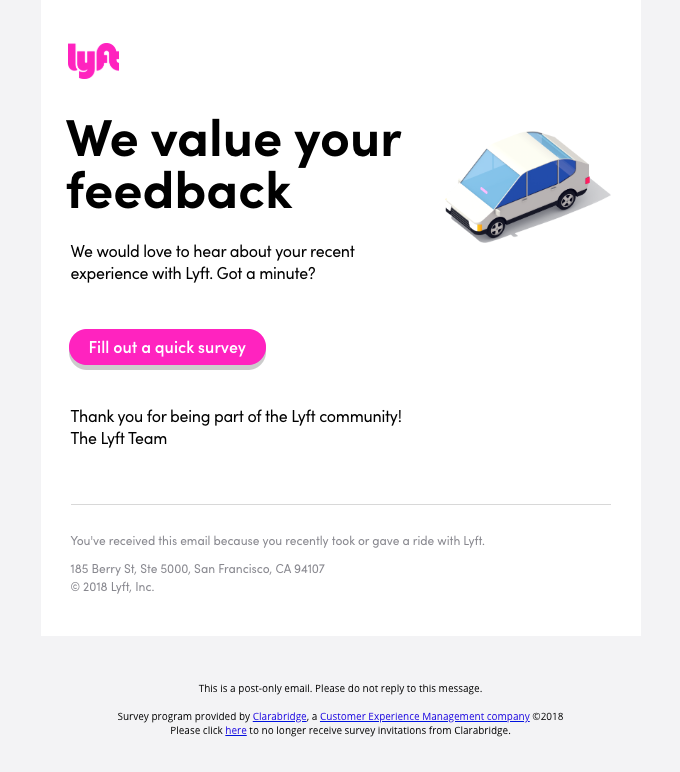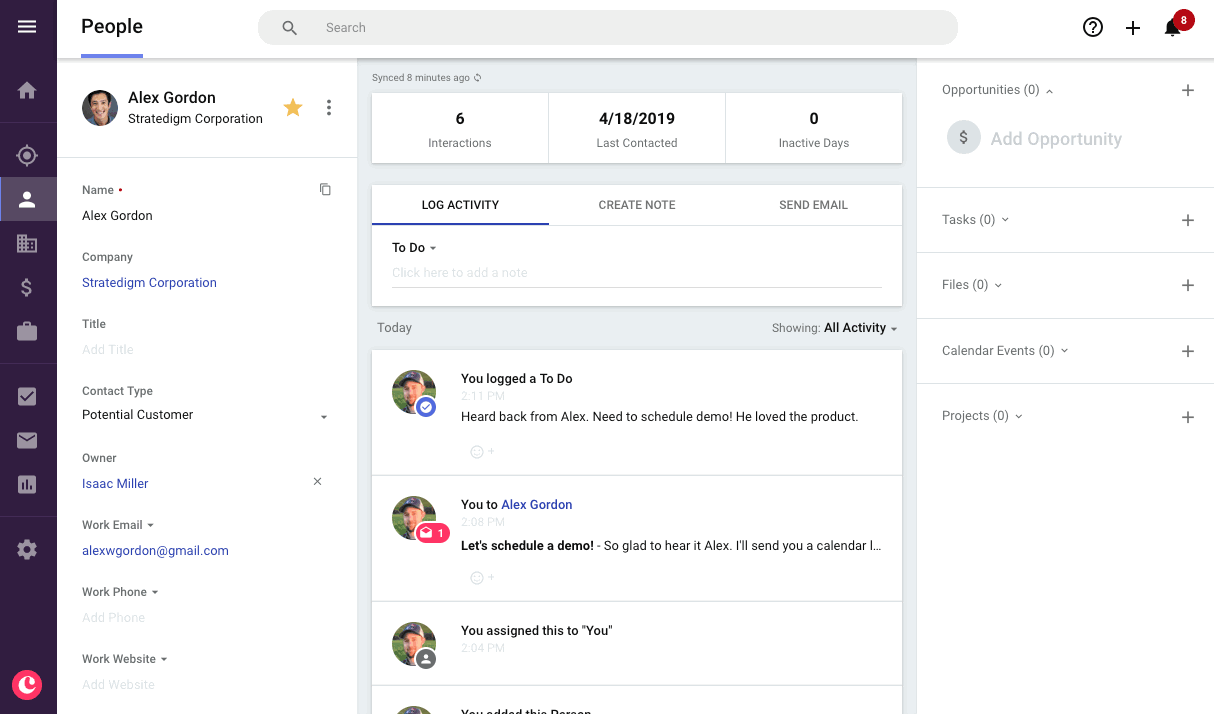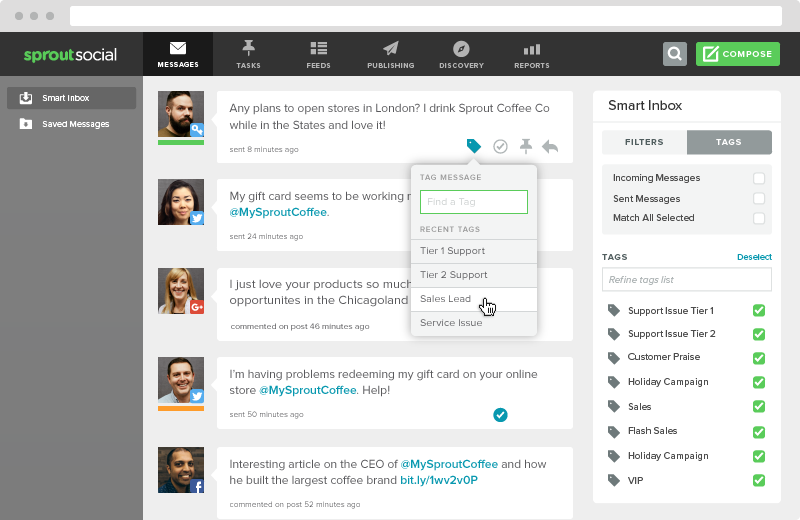The concept of putting your customers first is nothing new.
However, doing so in 2019 and beyond is about much more than just providing stellar customer service.
Food for thought: trust is the number one factor for consumers today when it comes to building long-term business relationships.
And creating that sense of trust doesn’t happen by accident.
Instead, it happens through consistent conversations with your customers. The more you understand your customers and walk in their shoes, the easier it is to serve their needs.
Enter the era of customer intimacy.
In this guide, we’ll break down everything you need to know about customer intimacy to transform buyers into loyal, long-term advocates.
What is customer intimacy, anyway?
Let’s start with a quick definition of customer intimacy before we get into the nitty-gritty.
Customer intimacy is the proactive process of aligning your business with the needs and values of your customers. This process involves building a back-and-forth relationship with customers, adapting your product and business based on their specific needs and pain points.
The principles of customer intimacy go hand in hand with the Relationship Era.
After all, consumers today crave personal connections with the brands they support. Creating that connection comes down to having meaningful conversations with customers and making sense of their behavior (think: pain points, objections and so on).
Why customer intimacy matters so much
Having conversations with customers might seem like a no-brainer.
That said, the benefits of consistent back-and-forth with your customers really can’t be overstated.
Below are three key reasons why companies should make customer intimacy a top priority.
Fewer churned customers
For starters, high customer churn rates are a widespread problem among businesses struggling to stay afloat.
Making the effort to have ongoing conversations and consistent touchpoints sow the seeds of customer loyalty. Being proactive beyond simply providing a product or service shows your customers that you’ve invested in them.
In turn, they’ll be more likely to invest in you rather than bounce to a competitor.
More word-of-mouth from satisfied customers
Modern customers aren’t shy about letting the world know how they feel about any given business.
By emphasizing customer intimacy and ensuring that your buyers have a positive experience, you’re more likely to create opportunities for customer marketing.
Every retweet, testimonial, or review represents powerful social proof that simply can’t be bought. Organic shout-outs from customers are arguably the best form of marketing for your business, authentic and prime for sharing with prospects.
Brands such as Chewy are a prime example of how customer intimacy can result in positive word-of-mouth. From surprise gifts to their generous return policy, Chewy consistently scores points with customers by showing that they care.

New opportunities to improve your product or service
If nothing else, focusing on customer intimacy allows you to better understand ways to improve your product or service.
Want to know which of your features your customers can’t live without? Wondering what new features they’re hungry for?
Just ask.
Establishing trust with customers gives you more specific, insightful feedback that you can apply to your business. The more you engage, the more you can learn.
Here are 10 strategies to foster customer intimacy
Customer intimacy requires a combination of multiple engagement strategies rather than a single “silver bullet.”
The following ten tactics represent actionable ways to foster relationships with customers and learn how to better serve them.
1. Curate client success stories and celebrate them
Putting your positive relationships with customers front-and-center throughout your sales and marketing is a smart first step towards creating a sense of intimacy.
Reviews, testimonials, and success stories represent some of your best marketing firepower. They also not only prove that your business creates satisfied customers, but also that you want to hear what your customers have to say.
For example, Casper publishes glowing reviews on their product pages and encourages new customers to do the same.

Casper also makes a point to celebrate their customers on social media. This includes retweeting shout-outs and personalizing replies to show off the human side of the brand.

2. Make yourself as accessible to customers as possible
Achieving customer intimacy means keeping clear lines of communication open between you and your buyers.
In other words, give your customers multiple avenues to ask questions and provide feedback. These customer communication channels might include:
- Social media (Twitter, Facebook Messenger)
- A support phone number
- Live chat
According to research by HubSpot, modern consumers expect a near-immediate response to questions and concerns. If real-time responses aren’t possible, try to make a point to at least respond within a 24-hour period. Letting questions or comments go unanswered is a bad look for modern businesses and could very well result in lost business.
3. Create community spaces for customers
Your customers represent a community that needs to be nurtured.
That’s why it’s crucial to provide customers with a space to ask questions, share content, and leave feedback about your business. Doing so makes it easier to spot potential concerns while also encouraging interactions between your customers.
For example, Squarespace has a specific community forum where users can answer each other’s questions and share their insight.

Of course, social media is arguably the easiest place to create a community space for most brands.
For example, Bear App consistently asks questions to its users and actively encourages feedback on Twitter. Responding to each and every mention, it’s clear that the company appreciates its customers and the community they’ve managed to build.

4. Ensure that your team understands your customers and product 100%
Customer intimacy requires employees to be hands-on and totally immersed in the customer journey.
As noted in our guide to sales prospecting training, it’s crucial that your employees know your customers inside and out.
Personas. Pain points. Motivations. All of it.
These elements will ultimately determine how your sales and marketing teams approach your customers and carry on conversations with them.
And similarly, it’s critical that those same teams are up-to-date on your latest launches, features, and product details.
5. Listen carefully to customer feedback (and respond to it, too)
Whether it’s a 140-character tweet or a 2,000-word email, customer feedback isn’t something that should ever fall by the wayside.
Each customer comment is a data point that helps you better understand what customers like or don’t like about what you’re selling.
Maybe it’s a UX issue on your website. Perhaps it’s a feature or product that people want to see.
Either way, make sure that you’re legitimately listening to feedback from customers and likewise letting those customers know that they’re being heard. Take this social example from Bellroy. People want to be acknowledged by the businesses they support even if they’re being told “no” or “not yet.”

6. Frequency touch base with your customers
Bear in mind that customer intimacy isn’t a one-way street.
Regularly reaching out to your customers ensures that you stay fresh in their minds. This also helps nip any potential customer problems in the bud before they snowball out of control.
Whether it’s check-in calls from your sales team or email surveys like this one from Lyft, frequent touchpoints are paramount to customer success.

7. Promote convenient customer policies
Anything you can do to make life easier on your customers is a plus.
Think about how widespread free shipping and flexible return policies have become. Such policies display confidence in your product as well as a commitment to your customers.
As highlighted by this shout-out to Bose, surprising your customers with personalized service can help create positive buzz on behalf of your brand.

8. Reward customer long-term loyalty
Remember: customers today are spoiled for choice in terms of the number of businesses they can support.
Exclusive deals and offers for long-term (think: one year-plus) customers is a low-hanging way to reward loyal customers. Doing so represents an incentive to keep customers in your pipeline longer, as well as opportunities to upsell and cross-sell to them.
9. Offer resources for continued customer success
Encouraging long-term customers means giving your customers fresh opportunities to explore your product.
Especially for SaaS brands, it’s important to promote resources and ongoing education to your customers. For example, Campaign Monitor regularly publishes blog posts, webinars, and templates to empower their customers to make the most of their email marketing platform.

These resources should ideally speak to the needs and pain points of your audience. That’s why “how-to” and simplified step-by-step content are so popular for SaaS companies in particular.
10. Interview your customers
Many of these tips center around having conversations with customers.
Of course, there’s no replacement for actually sitting down and interviewing your customers formally.
As highlighted in this guide to conducting an in-depth customer interview from Atlassian notes, formal interviews can help companies better empathize with their audience and realign their goals.
Customer interviews ideally should sample different types of customers (think: someone who’s been with you six months versus three years) and specific, product-focused questions (think: “If you could only keep three features of our product, what would they be?”).
What tools can help companies with customer intimacy?
With an emphasis on communication, customer intimacy requires a combination of sales and marketing tools to ensure that your efforts are both measurable and scalable.
What types of tools are we talking about, though?
CRM
A sales CRM is key to customer intimacy, plain and simple.
Capable of tracking each individual customer and their relationship from A to Z, a CRM such as Copper can hone in on individual customer needs as well as big-picture trends across your company.
For example, Copper’s activity log allows for straightforward tracking of any and all communication between your team and your customers. You can also input notes and reminders within the platform to ensure that you engage each customer consistently and with the proper message.

You can check out how Copper’s customer success team uses our CRM for more information on how our platform can assist with your customer intimacy efforts.
Social listening and monitoring tools
Being a good listener is key to customer intimacy.
Although businesses should obviously keep an eye on their inboxes, social mentions can often fall by the wayside if you aren’t exclusively listening for them.
For example, not all customers are going to necessarily @tag you on Twitter or Instagram when you mention you. Businesses with a high volume of mentions might also struggle with keeping track of them when bouncing between platforms.
With the help of social media monitoring tools like Sprout Social, businesses can track their mentions and text mentions across social media in a single platform. Users can also tag and categorize their mentions based on priority and mention type (think: customer support, sales leads, etc).

Another added bonus of a tool like Sprout is sentiment analysis. In other words, you can track whether or not the majority of your mentions across social media are positive, neutral, or negative. This helps businesses keep a pulse on their brand health overtime to ensure that customers stay happy.
Customer feedback and survey tools
We mentioned earlier that companies should regularly touch base with their customers to pick their brains.
Although you can do so manually via email, survey tools such as SurveyMonkey or Typeform can make the process much easier and quantifiable.
In short, survey tools allow you to ask open-ended questions (“Tell us how you feel about…”) as well as objective, score-based questions (“On a scale of one to ten…”). Gathering metrics such as a net promoter score from customers helps tie a measurable data point to customer satisfaction.
Each of these tools streamlines the process of engaging customers and gathering ever-so-valuable data to figure out how to improve your customer intimacy strategy over time.
What does customer intimacy mean to your company?
No matter what you’re selling, a deeper understanding of your customers and their needs will only help your company in the long-run.
And that’s what customer intimacy is all about.
By prioritizing customer relationships and uncovering new ways to engage with customers, you can build a better business and a more loyal base over time.
The tactics above coupled with tools like a CRM can make both happen sooner rather than later.
About the author: Grace is the Editor-in-Chief at Copper, the CRM that’s designed for and recommended by Google.